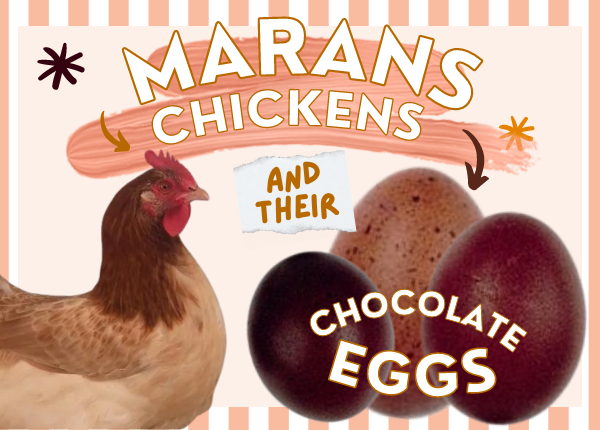
"Life is like a box of chocolates." Yes Forrest, and so is a Marans chicken's nest. "You never know what you're gonna get."
I'm assuming you're here about the eggs, right? Marans Chickens are famously associated with their deliciously dark, chocolate-brown eggs. They're also known for their frustrating unpredictability when it comes to achieving that lusted after egg color. Any Fifty Shades of Grey fans here? Well, there are one hundred and fifty shades of brown!
The color of a Marans' egg🥚 will differ depending on – brace yourself - her breed, her strain, the time in her season, the stage of her life, the hen herself, the weather, how posh her bed is (honestly), the quality of her feed and wellbeing, and basically how the stars align that night.
What I'm getting at is that you can't buy a Marans chicken and expect an Insta-worthy-egg in your basket the next day. It's not that simple.
First, I'm going to unscramble the egg situation for you by covering the ins, the outs, and the shades of brown of a Mirans' egg.
Oh yeah…and then I'll introduce you to the chickens! There's more to this easy-going breed than just their deep-brown eggs you know. Humans can be so fickle.
⚠️ A Friendly Health Warning: Due to descriptive requirements, this article may contain the word chocolate, quite a lot. Stop thinking about choco...oooohh, I think I might have some in the cupboard somewhere… 🍫
What's on the plate with this read:
Contents and Quick Navigation
Everything you Need to Know About Marans Eggs
- Which Breed of Chicken Lays the Darkest Brown Eggs?
- Why Are Marans Eggs So Desirable?
- What Makes Marans Chicken Eggs Dark Brown?
- What Is the Marans Color Chart?
- Which Variety of Marans Chicken Lays the Darkest Brown Eggs?
- How Do I Choose a Marans Chicken That Will Lay Dark Eggs?
- How Can I Get the Darkest Eggs Possible from my Marans Chicken?
- How Many Eggs Does a Marans Chicken Lay?
- How Long Will a Marans Chicken Lay for?
- How Big is a Marans Chicken Egg?
- Are Marans Chickens Broody?
All About Marans Chickens
- Do Marans Chickens Make Good Pets?
- How Big is The Marans Chicken?
- Can You Get Bantam Marans?
- Do Marans Work Well as Meat Birds?
- Are Marans Chickens Suitable for Beginners?
- Why Is It Difficult to Hatch Marans?
- What's The Difference Between French and English Marans?
- What Varieties of Marans Chicken are There?
- What Marans Chicken Colors are Recognized?
- Do the Varieties of Marans Chickens Differ?
- How Do the Varieties of Marans chickens Differ?
- How To Care for Marans Chickens
- How Long Do Marans Chickens Live For?
- Do Marans Chickens Have Health Issues?
- A Brief History of Marans Chickens
- How To Find Out More About Marans Chickens
- What Are the Downsides to Keeping Marans Chickens?
What comes first – the chicken or the egg? With the Marans, it's almost always about the egg…
Here's Everything You Need to Know About Marans Eggs

Which Breed of Chicken Lays the Darkest Brown Eggs?
The Marans chicken lays the darkest brown eggs out there. They can be deep reddish-brown or almost black. They really do look like they're chocolate eggs! Don't let the little ones get confused.
Why Are Marans Eggs So Desirable?
Mainly because their dark brown color is rare, but the French insist they taste amazing too. Marans' egg membranes are thicker than those in the eggs of other chicken breeds, and the pores in the egg are smaller (hmmm…I wonder if they do Marans face cream?) This makes the eggshells super-tough, so the eggs stay fresher for longer resulting in bright, fresh-looking yolks and less likelihood of Salmonella.
Most backyard breeders agree that Marans eggs taste great – but not really any better than other fresh, free-range eggs. They do look better – so it's probably all in the mind - but French chefs are loyal to their local breed and will only cook with Marans Eggs. Only the best, darling!
What Makes Marans Chicken Eggs Dark Brown?
Paint. Kind of. The Marans chocolate-brown eggs are a piece of art which start off like your regular white eggs, but as mama lays her eggs she deposits a dark brown pigment onto them, marking them as her own.
This is where the luxury accommodation comes in! If you want to start your mornings harvesting those deliciously-deep-brown eggs, then you'll need to invest in your Marans' bedding. Think super-soft, 5-star hotel bedding. Rough bedding or even cleaning eggs can scrape off or scar their pigment, resulting in uneven or lighter coloration.
What Is the Marans Color Chart?
Marans eggs are graded using a breed-specific egg color chart. Ever been wedding dress shopping? Then you'll know that there are a million shades of white and ivory out there. Eggs are the same.
Okay, 'a million shades' is a tad dramatic of me. Marans eggs are graded using a guide of 9 color depths. There are very detailed descriptions of what constitutes each color grade, but to summarise for you:
Anything 1-3 doesn't cut it as a Marans egg, 4-7 is a good breed, and 8-9 is an epic egg. Download your Marans Egg Shade Color Chart here:
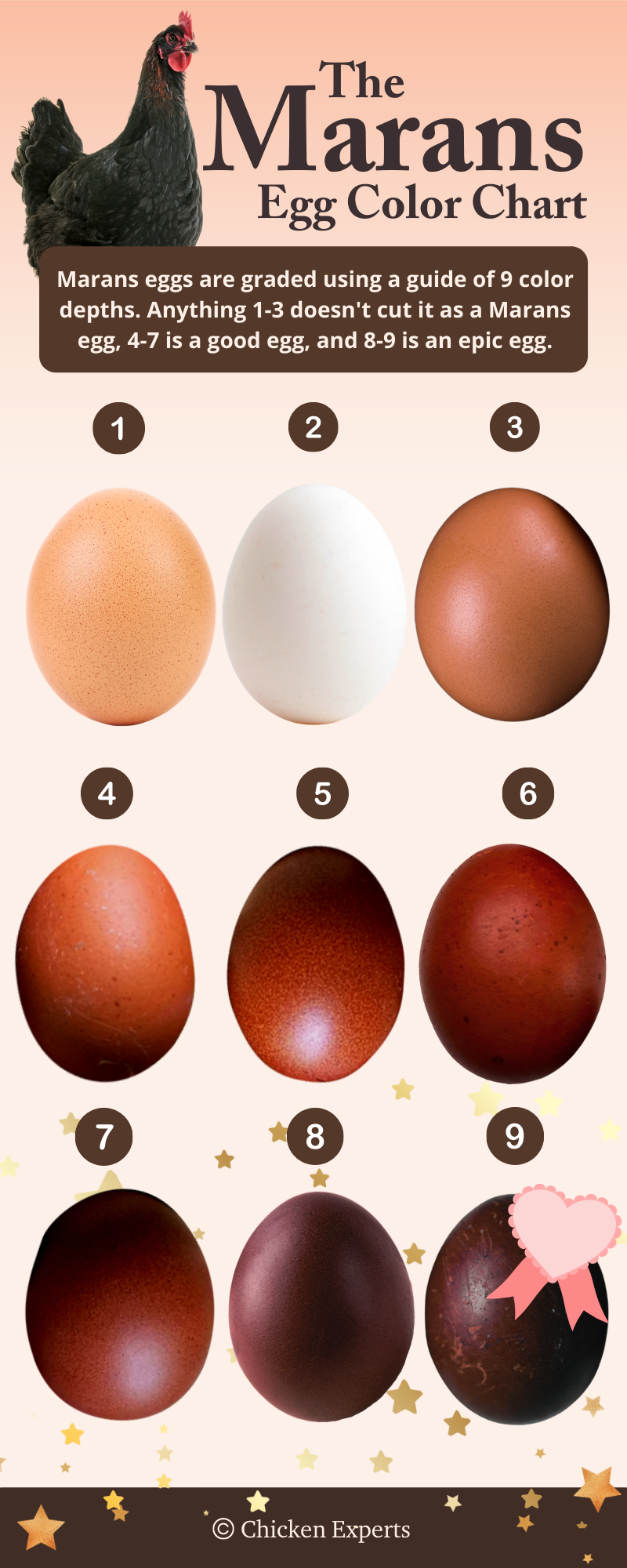
How Do I Choose a Marans Chicken That Will Lay Dark Eggs?
Disappointment is rife out there with new Marans keepers who don't do their homework first (well done you!) There are so many things that impact the shade of egg a Marans lays, that it's tricky – some might say impossible - to know what shade of egg you'll be getting from your girlies.
The color of the egg is hereditary, so selecting darker hatching eggs will up your odds of the pullet laying darker eggs. If you don't have full knowledge of the lineage though, it's still a guessing game. If mum's egg was fertilized by a rooster who came from a lighter egg – she'll lay eggs of a lighter shade than the one she hatched out of. If the roo came from a darker egg than the hen did, then you're in for a treat as she's likely to lay eggs a little darker than her own was.
If you're keeping Marans purely for their dark eggs, then go to a reputable breeder and make your eggspectations very clear. It's the only way to be certain of your chicken's lineage. Even hatcheries struggle with this breed, so trying to wing it won't work.
Which Variety of Marans Chicken Lays the Darkest Brown Eggs?
The Black French Marans lays the darkest, chocolatey-brown eggs of any chicken breed. We have a champion in the wings here! 😍
All other varieties of Marans still lay dark to very dark eggs. Now - trust me on this - their individual bloodlines will be a better indicator of how dark their eggs will be than their color variations. The White Marans is thought to lay the lighter eggs of the breed, but they could be darker than any other color variants eggs, if she's a well-bred young lady from the right side of town!
How Can I Get the Darkest Eggs Possible from my Marans Chicken?
Once you've selected your pullet and she's settled into her new pad, The first eggs your Marans lays will be her darkest. These will be smaller than her standard/future egg size, so that pigment doesn't need to stretch as far, hence the darker shade.

So, when that first chocolatey clutch arrives you absolutely should savor the moment (and the egg), just don't eggspect her to keep it up. There's nothing worse than the look of disappointment in your parents' eyes. Remember that as your Marans pullet settles into her standard shade.
The Marans will lay her darkest eggs in her first six months, and whilst they'll get lighter as that time goes on, they're still very dark eggs. They still win wings down in the battle of the breeds!
Your girls will lay darker eggs at the start of each cycle too: think of it as a fake tan, it wears thin after a few days!
If your mama goes broody, has her molt, or is coming out of a warm season into a cooler one, her eggs will get a fresh fake tan and the darker to lighter cycle will start again.
Caring for your flock and serving up some healthy grub can help you get darker eggs. It's thought that the levels of certain vitamins in the Marans diet may be associated with egg quality and color. Check out how to cater for your chicken with Chickenpedia's nutrition guide. Put those yummies in her tummy!
How Many Eggs Does a Marans Chicken Lay?
Marans chickens lay 150 - 200 eggs a year. They're considered decent layers and may lay more than 3 or 4 a week if you treat them well, and strike lucky.
We surveyed over 300 Marans owners to find out if these stats were fact or fiction. 73% said 3 eggs a week was realistic and 20% said it was more likely to be 4 eggs a week.


How Long Will a Marans Chicken Lay for?
Marans chickens start to lay at 32 weeks of age. That's a bit later than most chicken breeds. They'll lay throughout the year, but they may slow down in the hotter weather. Healthy Marans will lay for five years, so you can cluck up 700 eggs or more from these marvelous mamas.
How Big is a Marans Chicken Egg?
Marans lay extra large eggs. Marans pullet eggs should weigh 65g, though fully grown hens will likely lay eggs that weigh between 75 and 80g. Also, don't be weirded out if they lay a ball. Marans eggs are sometimes spherical in shape. It's normal, don't call the vet, but also don't leave them on the counter because they roll!
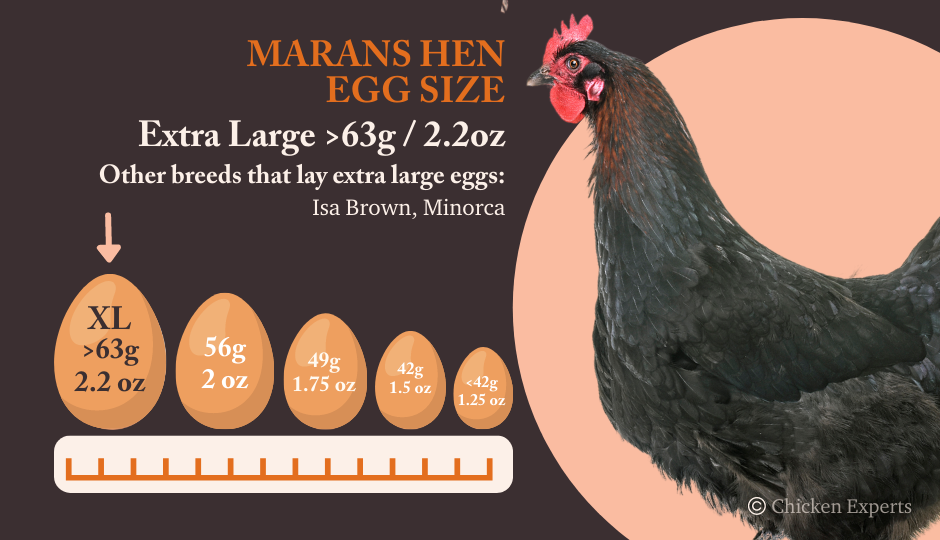
Are Marans Chickens Broody?
Marans are not particularly broody, but their most maternal side will show itself in their second and third seasons. When they do hatch a clutch French Marans tend to be good mamas. Awww.
That said, the Brits didn't want them all soppy and sitty, so English Marans were bred by many to be less broody. As a result, some English Marans can be a smidgen less motherly.
"You only want me for my Eggs!"
So, we've accomplished the fact that Marans Chickens lay eggs-ellant eggs, but that's not all these gals have going for them. There is more to this beauty than her coveted eggs.
Do Marans Chickens Make Good Pets?
Marans hens make great pets❤️, they're docile and easy to handle, low maintenance, hardy, and not aggressive with people. The friendlier amongst the flock might follow you around the garden for the chance of a treat, but not into the house for a cuddle: they're not super affectionate.

67% of Marans owners we asked about their chickens said that they’ll be choosing Marans again for their future flocks.

What is The Temperament of Marans Chickens?
Marans chickens mix well with other breeds of chicken. They're relaxed and easy going, though the roosters might occasionally show aggression towards other roosters. They'll find themselves in the middle of the pecking order, possibly nearer the top, not likely at the bottom. They're not the most exciting souls - more of your girl next door personality – they are gorgeous though.
How Big is The Marans Chicken?
Marans are large, well-built birds. Marans hens weigh 6.5 lbs and are 20 inches tall. Marans Roosters weigh 8lbs and are 22 inches tall. These are averages, of course!
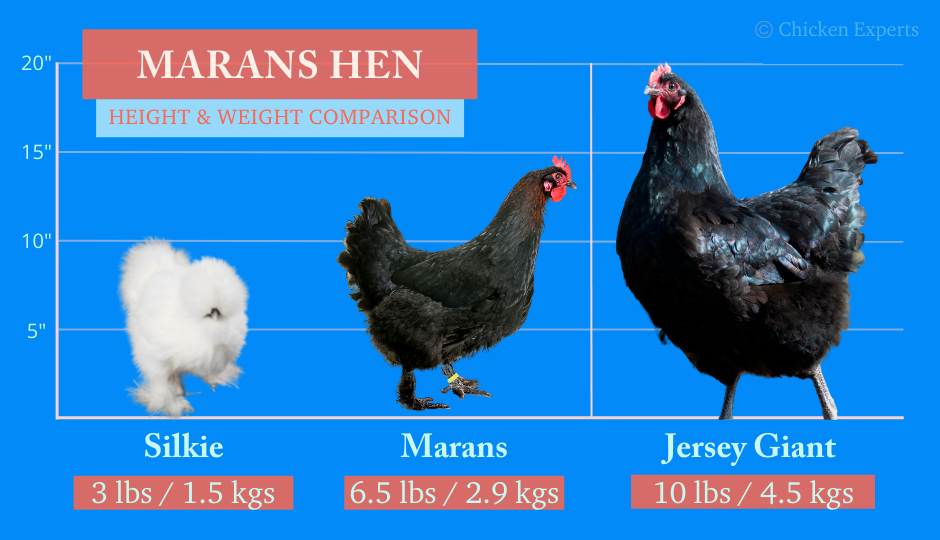
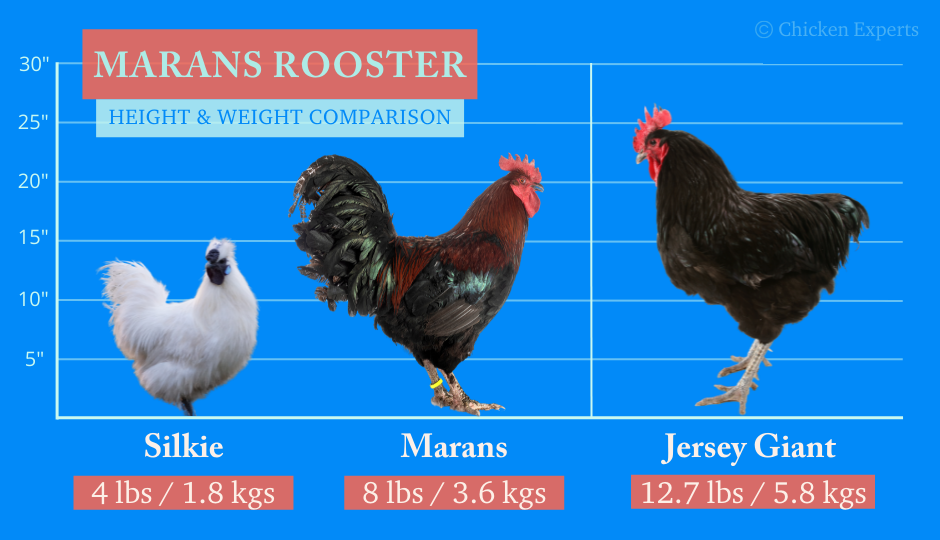
Can You Get Marans Bantams?
Yep indeedy! If you are looking for less 'oomph' and more 'awww' then bantam Marans are on offer! Bantams Marans hens weigh 24oz on average, whilst bantam Marans roosters weigh up to 28oz. Marans bantams are easy to look after too, unlike some other bantam breeds they're no more demanding than the full-sized breed.

Do Marans Work Well as Meat Birds?
Marans are great meat birds. They were bred for their size and provide a fair-sized carcas. They do take almost twice as long to mature as other meat birds but give them a break, they've been delivering beautiful eggs for you, they've not been purely focussed on bulking up!
Are Marans Chickens Suitable for Beginners?
Marans chickens are great for beginners. They're hardy birds that need little to no extra care. They're happy foraging, they mix well, they're not flighty or awkward, and they've got lovely manners.
Breeding and hatching Marans is not as easy as with other chicken breeds. If you're new to hatching, then this may not be the best breed to get off the ground with.
Why Is It Difficult to Hatch Marans?
The breed has a lower success rate than other breeds in hatch rates because of their challenging first step into the world.
Those nice thick eggshells look great from the outside, but they're not so great for the little lovelies that are trying to break out. Managing humidity levels carefully helps, with lower humidity levels earlier on and raised humidity levels just in time for chicks to hatch. Get the humidity level too high and the chicks don't make it. Tricksy!
Despite how challenging they can be to hatch, Marans need their mamas. Hens get much better hatch rates than incubators. There's that quick fix ruled out.
What's The Difference Between French and English Marans?
It's all about the pins! When the Brits started to breed their own Marans in the early 1930's they preferred a fuzz-free leg for cleanliness, and so English Marans have clean legs whilst French Marans have retained their European-style lightly feathered legs.
Whilst we're on the subject. It's debatable whether French Marans should just be 'Marans', as the need for adding 'French' only really arose to help differentiate them from their smooth-legged derivents. They're all French really!
There aren't many chicken breeds in this special fluffy-foot gang. The French Marans chicken is one of only six breeds that can parade their feathery feet down the catwalk with pride. Here come the girls…
Marans, Faverolles, Cochins, Sultans, Brahmas and Silkies

What Varieties of Marans Chicken are there?
The focus on breeding Marans shifted from being truly dual-purpose to achieving the darkest eggs possible, it was never really about honing in their looks, which is why there are now so many variations of Marans. The main variations are as follows
- Birchen
- Black
- Black Copper
- Black-Tailed Buff
- Blue
- Blue Copper
- Blue Wheaten
- Brown Red
- Columbian
- Golden
- Salmon
- Silver Cuckoo
- Wheaten
- White
All of these variations can be found as French or English varieties too, and you can get bantams. Plenty of poultry to pick from, peeps!
What Colors of Marans Chicken are Recognized?
The U.S. standard recognizes French Black, French Black Copper, French Wheaten, and French White Marans.
"The Standard describes Marans as having shanks that are lightly feathered down the outer sides. It lists the absence of feathers on shanks as a disqualification. So, if you plan to exhibit your Marans, be sure to get the feather-legged French type Marans of a color variety currently listed in the Standard."(Cackle Hatchery) hyperlink
Do the Varieties of Marans Chickens Differ?
Are you finding it hard to get a simple answer on how the varieties of Marans chicken differ in temperament or egg type? I feel your pain!
When I was new to the world of Marans chickens, I really did get my feathers in a flap with all the contradictory information out there on this breed. "They lay dark brown eggs - but they don't always." "They really must be free-range - but they handle coops very well." "Hens are always broody – but they're not often broody." Arrrgghhhh!
Trying to get to the bottom of this rabbit hole can be like finding a baby Bantam in a barn. From getting to know lots of Marans' owners I've learned one thing: they're all different depending more on their individual strains than on their color variation.
Sure, this is nature, all chickens differ from individual to individual. Marans were bred purely for purpose, never to standardise their looks or temperaments. The vibrant variations that we're now blessed within this breed is – for all intents and purposes – part of the eggs-periment!
How Do Varieties of Marans Chickens Differ?
Whilst Marans are a tricky breed to second guess when comparing variants in detail or shopping for egg color, as a breed, they're relatively straightforward. You're getting a large, friendly, dual-purpose chicken that will lay up to 200 dark brown eggs. The only thing that seems to vary is how dark those eggs are, how broody Mum is, and how much cock-fight-blood is still in Dad's system.
The right stock is imperative if you want to predict your poultry's temperament, broodiness, or the chocolatiness of their egg color.
There are a few color-coded-trends that owners seem to agree on, but they're definitely not uncrackable. A White Marans can still lay a bordering-on-black egg.
- The Black Copper Marans are the most popular (yet hard to get your paws on) as it's thought the most likely to lay very dark brown eggs of 8-9 on the Marans egg-color chart.
- Black & Black-tailed Buff Marans lay very dark eggs of 7-9 on the Marans Egg-color chart
- Wheaten & Birchen lay very dark reddish-brown, copper eggs which average a 7 on the Marans egg-color chart
- Golden & Silver Cuckoo Marans' eggs are described as dark chocolate brown, reddish-brown, or copper brown and can be speckled
- Blue & Blue Copper Marans chickens thought to be a slightly more friendly variety and also lay very dark eggs
- Splash Marans' eggs are not usually quite as dark as other variations, but the chickens are said to have a sweet temperament and they're very pretty
- White Marans chickens tend to have lovely temperaments, and lay lighter eggs of around 4-6 on the chart, but can surprise you!
"The (White Marans) eggs are a beautiful, very dark brown, usually I'm seeing 3 - 5 on the Marans egg color chart. Hens are dependable layers, although they did seem to take a little longer to start laying than others. Overall, the White Marans have been a lovely surprise and keepers for sure."(McMurray Hatchery Customer)
How To Care for Marans Chickens
Marans are a great free-range breed. They're fuss-free foraging birds, they're hardy, and they'll roam and peck happily all day long. They aren't flighty birds so containing them is easy enough.
They're big enough to defend themselves if they have to. Did I mention they were bred from fighters? Boxing is in their blood.
White Marans do stand out like a sore thumb, so if you have a lot of predators lurking around, they may not be the best choice for free-range. "Hey, foxy…I'm over here!" Make sure you predator-proof your poultry people!
Marans chickens get fat fast. Poor things. They aren't the type to grumble and are happy in a coop, but they need their gym membership to stay healthy, so make sure they get out often.
Marans are large chucks and need 5 square feet per chicken, ideally. They also need 10 inches of roosting space so they can space themselves out in the warmer months. A standard nesting box will be fine for three Marans chickens. Despite being bigger birds, they're not demanding divas.
How Long Do Marans Chickens Live For?
Marans chickens have a lifespan of eight years. Better hope brown doesn't go out of fashion as you'll be chomping on chocolate-brown eggs for a good while.
Do Marans Chickens Have Health Issues?
There is a downside to breeding with tunnel vision. By breeding for those desirable dark eggs, we've inadvertently made them hard to hatch out of! The hatch rate of Marans is lower than that of other breeds.
Marans' single combs are susceptible to frostbite, so whilst they're a hardy breed and they love moist environments, you'll need to keep an eye on this.
As a peckish meat breed a lack of exercise can result in obesity as they gain weight quickly.
The English Marans can be the victims of pecking on their bare legs if kept with other breeds. Equally other clean-legged breeds can pick curiously at the feathered-feet of the French Marans. Crikey, they can't win!
French Marans are more susceptible to scaley mites, and at higher risk of frostbite should their feet get wet, so they'll benefit from sand bedding. Then there's the general 'ick' factor. Poopy ankles are not a good look.
A Brief History of Marans Chickens
Marans chickens were bred in the 1800s from feral fighting birds imported into the French port town of Marans. They were first bred with the plan of breeding – you've guessed it - a great dual-purpose bird. They were initially cross bred with Croad Langshan and possibly Faverolles to increase their meat yield, and whilst they're still big birds, they're now bred primarily for their deliciously deep brown chocolatey egg color.
If you're keen to know more about the breed's history, and their travels around the world, check out their story here, courtesy of The Marans Club
How To Find Out More About Marans Chickens
Anything this cute yet complicated must have a club! There are loads of great clubs and communities that specialize in Marans. If you are considering keeping this statement breed, then please do your research first. Poor breeding hasn't always helped this gorgeous gal out, and she deserves to be nurtured. We all do.
Here's just a clutch of the best Marans gangs to go to:
- UK: The Marans Club of Great Britain
- US: Marans Chicken Club USA
- FR: The Marans Club of France
- DE: Marans Club of Germany
- AUS: French Marans Club of Australia
"Marans are friendly and docile. They aren't terribly broody, but are good foragers and a nice, hardy breed."(Marans of America Club)
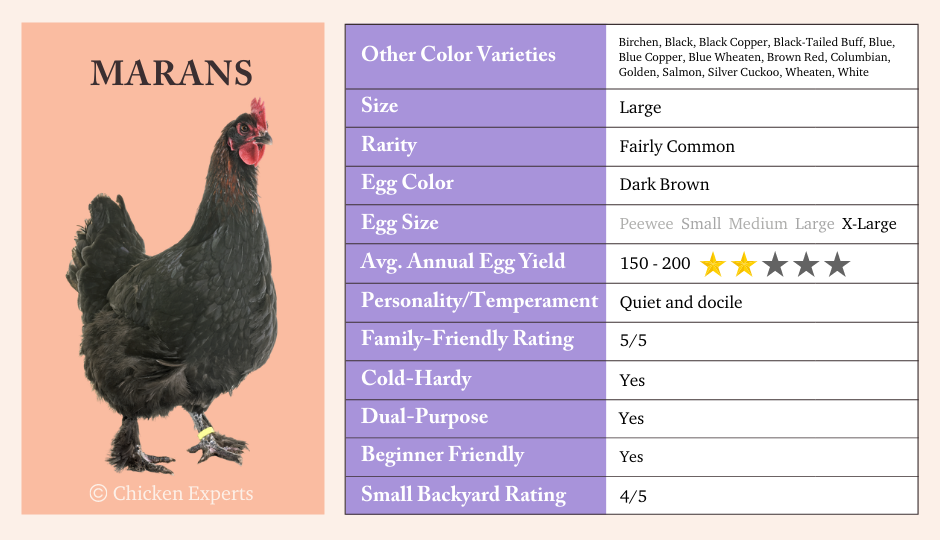
What Are the Downsides to Keeping Marans Chickens?
Marans are a great breed, but there are a few reasons why they may not be your perfect hatch match.
French Marans can get frostbite if kept in damp and cold conditions, so whilst they are cold hardy, you might need to invest in some sand bedding for them to dry off in.
French Marans are sociable in an aloof kinda way. They mix fine with other breeds, but clean-legged breeds sometimes peck at their feet and can make them super sore. Clearly, they're jealous!
Marans are known to be hard to sex, even the sexperts at Cackle Hatchery confess that their success rates are lowered with the metro-sexual Marans
“…Most of our breeds we can average 90% accuracy on gender sexing. However, with the French Marans breed, it is more difficult for the vent sexor to make this determination, so for this breed our guarantee is 75% accuracy.” (Cackle Hatchery)
There are lots of tricks to sexing Marans, but loads of keepers swear by this cheeky little wing thing:
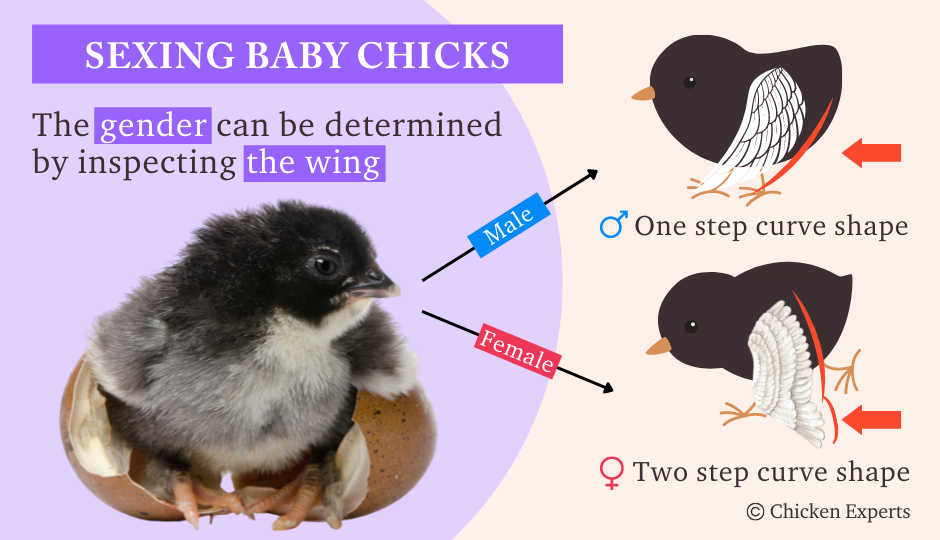
Are You Down With The Brown?
Firstly, thanks for staying 'til the end! I know this was a whopper read but kudos to your research commitment!
Ready to play the chocco lotto? Not knowing egg-sactly what she's got in store for you each day is half the fun of keeping the mysterious Marans. They're all large, they're all scrumptious, and they all deserve a good home. I'm talking about the chickens and the eggs now!
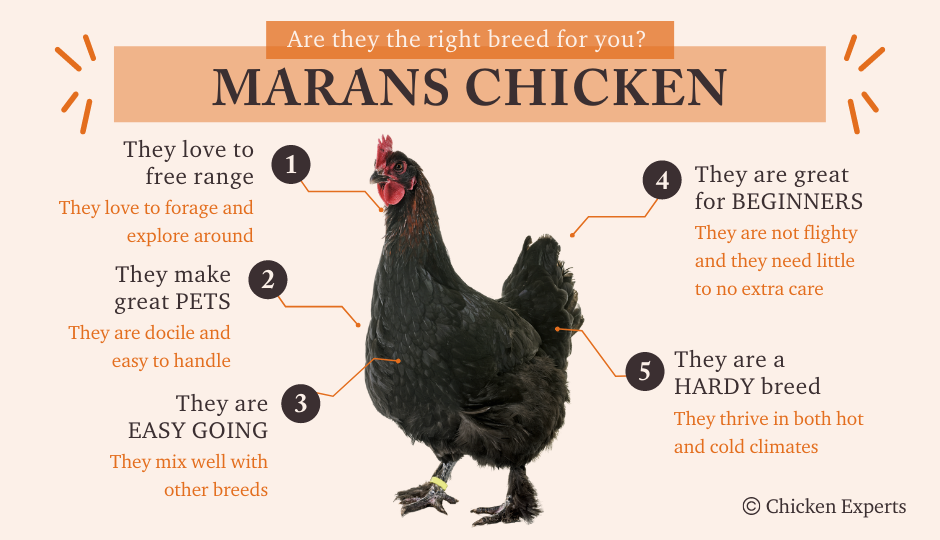
Whatever breed gets you broody, there are endless questions that crop up in any coop: Is she okay? Is that normal? Is he really what I thought he was? Should I call the vet? Dude, where the cluck are my eggs?
Sign up for any Chickenpedia course, and get unlimited access to key facts, validated information, easy guides, and 1-2-1 expert advice. Meet like-minded chicken nutters and share tips, ideas, and stories. Join the gang here.











Leave a comment (all fields required)